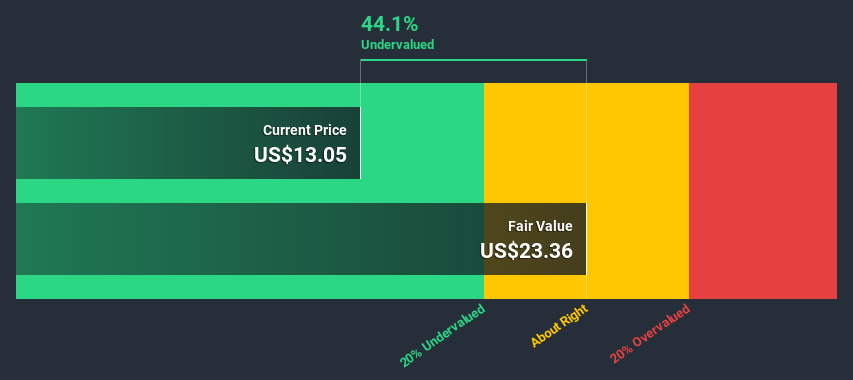- United States
- /
- Interactive Media and Services
- /
- NasdaqGM:BLCT
BlueCity Holdings Limited's (NASDAQ:BLCT) Intrinsic Value Is Potentially 79% Above Its Share Price

In this article we are going to estimate the intrinsic value of BlueCity Holdings Limited (NASDAQ:BLCT) by taking the expected future cash flows and discounting them to today's value. We will use the Discounted Cash Flow (DCF) model on this occasion. Believe it or not, it's not too difficult to follow, as you'll see from our example!
Companies can be valued in a lot of ways, so we would point out that a DCF is not perfect for every situation. If you want to learn more about discounted cash flow, the rationale behind this calculation can be read in detail in the Simply Wall St analysis model.
See our latest analysis for BlueCity Holdings
Crunching the numbers
We are going to use a two-stage DCF model, which, as the name states, takes into account two stages of growth. The first stage is generally a higher growth period which levels off heading towards the terminal value, captured in the second 'steady growth' period. To start off with, we need to estimate the next ten years of cash flows. Where possible we use analyst estimates, but when these aren't available we extrapolate the previous free cash flow (FCF) from the last estimate or reported value. We assume companies with shrinking free cash flow will slow their rate of shrinkage, and that companies with growing free cash flow will see their growth rate slow, over this period. We do this to reflect that growth tends to slow more in the early years than it does in later years.
Generally we assume that a dollar today is more valuable than a dollar in the future, so we need to discount the sum of these future cash flows to arrive at a present value estimate:
10-year free cash flow (FCF) estimate
| 2021 | 2022 | 2023 | 2024 | 2025 | 2026 | 2027 | 2028 | 2029 | 2030 | |
| Levered FCF (CN¥, Millions) | CN¥95.2m | CN¥297.2m | CN¥331.4m | CN¥360.0m | CN¥384.0m | CN¥404.3m | CN¥421.7m | CN¥437.0m | CN¥450.8m | CN¥463.5m |
| Growth Rate Estimate Source | Analyst x2 | Analyst x1 | Est @ 11.49% | Est @ 8.65% | Est @ 6.67% | Est @ 5.28% | Est @ 4.31% | Est @ 3.63% | Est @ 3.15% | Est @ 2.82% |
| Present Value (CN¥, Millions) Discounted @ 8.6% | CN¥87.7 | CN¥252 | CN¥259 | CN¥259 | CN¥254 | CN¥246 | CN¥236 | CN¥226 | CN¥214 | CN¥203 |
("Est" = FCF growth rate estimated by Simply Wall St)
Present Value of 10-year Cash Flow (PVCF) = CN¥2.2b
The second stage is also known as Terminal Value, this is the business's cash flow after the first stage. The Gordon Growth formula is used to calculate Terminal Value at a future annual growth rate equal to the 5-year average of the 10-year government bond yield of 2.0%. We discount the terminal cash flows to today's value at a cost of equity of 8.6%.
Terminal Value (TV)= FCF2030 × (1 + g) ÷ (r – g) = CN¥464m× (1 + 2.0%) ÷ (8.6%– 2.0%) = CN¥7.2b
Present Value of Terminal Value (PVTV)= TV / (1 + r)10= CN¥7.2b÷ ( 1 + 8.6%)10= CN¥3.1b
The total value, or equity value, is then the sum of the present value of the future cash flows, which in this case is CN¥5.4b. To get the intrinsic value per share, we divide this by the total number of shares outstanding. Compared to the current share price of US$13.1, the company appears quite undervalued at a 44% discount to where the stock price trades currently. Valuations are imprecise instruments though, rather like a telescope - move a few degrees and end up in a different galaxy. Do keep this in mind.

Important assumptions
The calculation above is very dependent on two assumptions. The first is the discount rate and the other is the cash flows. You don't have to agree with these inputs, I recommend redoing the calculations yourself and playing with them. The DCF also does not consider the possible cyclicality of an industry, or a company's future capital requirements, so it does not give a full picture of a company's potential performance. Given that we are looking at BlueCity Holdings as potential shareholders, the cost of equity is used as the discount rate, rather than the cost of capital (or weighted average cost of capital, WACC) which accounts for debt. In this calculation we've used 8.6%, which is based on a levered beta of 1.051. Beta is a measure of a stock's volatility, compared to the market as a whole. We get our beta from the industry average beta of globally comparable companies, with an imposed limit between 0.8 and 2.0, which is a reasonable range for a stable business.
Moving On:
Whilst important, the DCF calculation shouldn't be the only metric you look at when researching a company. The DCF model is not a perfect stock valuation tool. Rather it should be seen as a guide to "what assumptions need to be true for this stock to be under/overvalued?" For instance, if the terminal value growth rate is adjusted slightly, it can dramatically alter the overall result. Can we work out why the company is trading at a discount to intrinsic value? For BlueCity Holdings, we've put together three fundamental aspects you should further examine:
- Risks: To that end, you should be aware of the 1 warning sign we've spotted with BlueCity Holdings .
- Future Earnings: How does BLCT's growth rate compare to its peers and the wider market? Dig deeper into the analyst consensus number for the upcoming years by interacting with our free analyst growth expectation chart.
- Other High Quality Alternatives: Do you like a good all-rounder? Explore our interactive list of high quality stocks to get an idea of what else is out there you may be missing!
PS. Simply Wall St updates its DCF calculation for every American stock every day, so if you want to find the intrinsic value of any other stock just search here.
If you decide to trade BlueCity Holdings, use the lowest-cost* platform that is rated #1 Overall by Barron’s, Interactive Brokers. Trade stocks, options, futures, forex, bonds and funds on 135 markets, all from a single integrated account. Promoted
Valuation is complex, but we're here to simplify it.
Discover if BlueCity Holdings might be undervalued or overvalued with our detailed analysis, featuring fair value estimates, potential risks, dividends, insider trades, and its financial condition.
Access Free AnalysisThis article by Simply Wall St is general in nature. It does not constitute a recommendation to buy or sell any stock, and does not take account of your objectives, or your financial situation. We aim to bring you long-term focused analysis driven by fundamental data. Note that our analysis may not factor in the latest price-sensitive company announcements or qualitative material. Simply Wall St has no position in any stocks mentioned.
*Interactive Brokers Rated Lowest Cost Broker by StockBrokers.com Annual Online Review 2020
Have feedback on this article? Concerned about the content? Get in touch with us directly. Alternatively, email editorial-team (at) simplywallst.com.
About NasdaqGM:BLCT
BlueCity Holdings
BlueCity Holdings Limited operates a platform for LGBTQ community primarily under BlueCity brand in the People’s Republic of China, India, South Korea, Thailand, and Vietnam.
Excellent balance sheet and slightly overvalued.
Market Insights
Community Narratives




